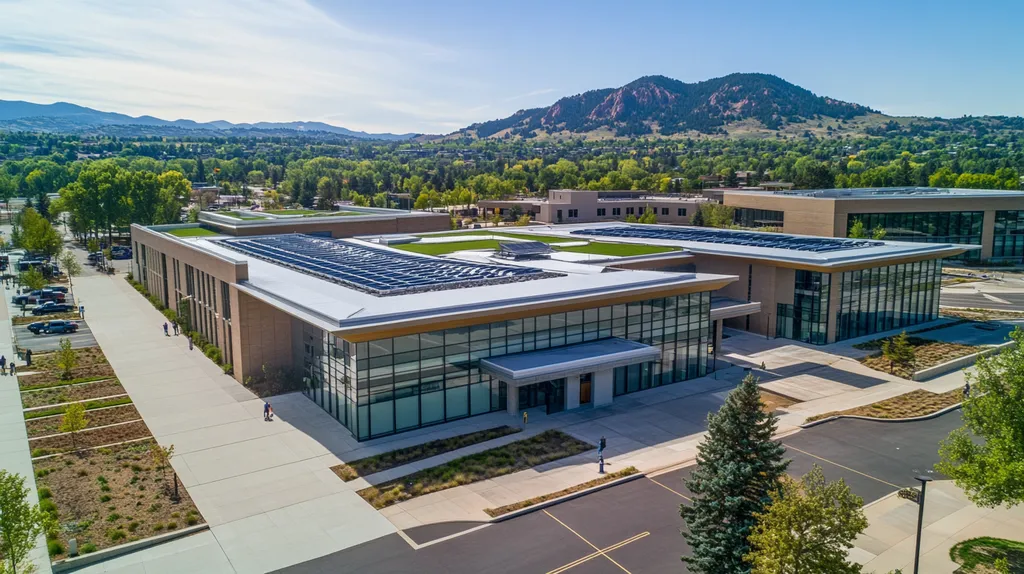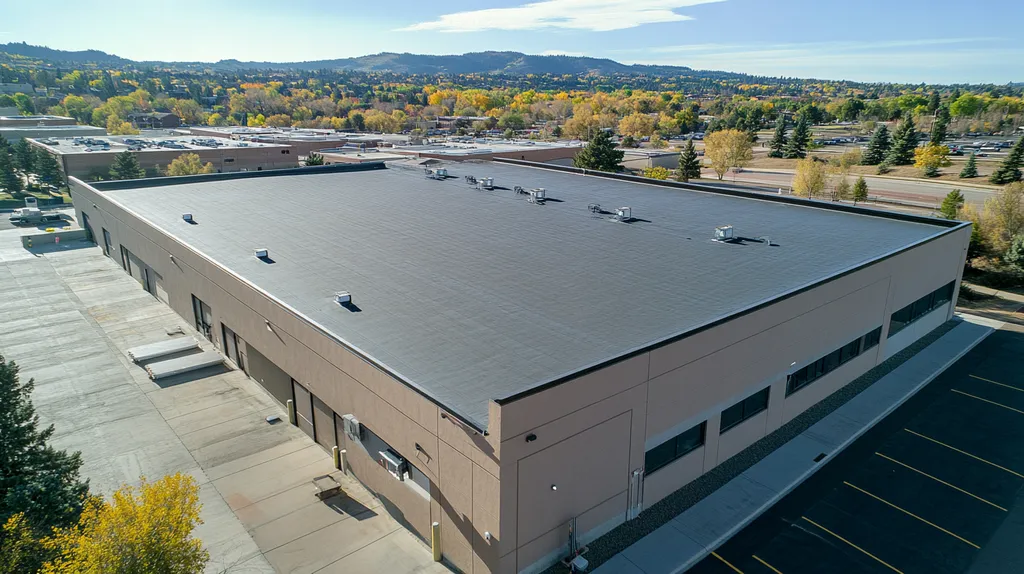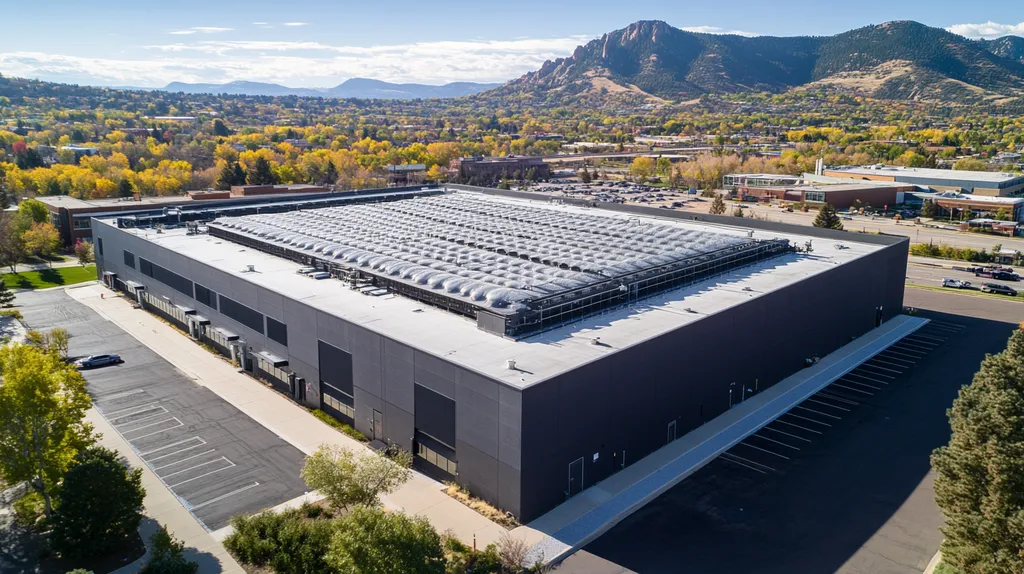Every year, poorly maintained rooftop equipment causes over $2.5 billion in commercial roof damage across North America, with 73% of premature roof failures directly linked to equipment-related issues.
From HVAC systems to solar installations, modern commercial roofs support an increasingly complex ecosystem of mechanical and electrical components that demand careful integration and ongoing maintenance.
This comprehensive guide examines how rooftop equipment impacts maintenance planning, exploring critical aspects of system design, implementation, and optimization strategies that protect both equipment investments and roof integrity.
SECTION 1: FUNDAMENTAL CONCEPTS
Commercial rooftop equipment represents a critical intersection of building functionality and roof integrity. Studies show that 73% of premature roof failures stem from improperly maintained or installed rooftop systems. These essential components, from HVAC units to solar installations, create unique maintenance challenges that impact both operational costs and roof longevity. Understanding their roles and requirements is fundamental to developing effective maintenance strategies.
Introduction to Rooftop Equipment
Modern commercial roofs support an increasingly complex ecosystem of mechanical, electrical, and sustainable energy systems. Each installation creates potential vulnerabilities in the roofing membrane, making proper maintenance crucial for preventing water infiltration and structural damage.
HVAC systems dominate rooftop installations, typically occupying 25-40% of available roof space. Their size and weight distribution require careful planning to prevent membrane compression and ensure proper drainage patterns around units.
Communication equipment, satellite dishes, and security systems add another layer of complexity. These lighter but numerous installations often require frequent access, creating additional wear patterns on roof surfaces.
Equipment platforms and walkway systems protect the roof membrane while providing safe access for maintenance personnel. However, these protective measures themselves require regular inspection and maintenance to prevent becoming sources of roof damage.
Types of Rooftop Systems Used
A well-run operations and maintenance program increases safety and efficiency while protecting rooftop equipment investments. Regular maintenance following manufacturer specifications ensures optimal performance and prevents equipment-related roof damage. (source: Pacific Northwest National Laboratory)
Mechanical ventilation systems, including exhaust fans and air handlers, require specific mounting configurations. These installations must maintain proper clearances while ensuring weathertight seal integrity around penetrations.
Solar arrays and green roof installations represent newer challenges for maintenance planning. Their presence demands specialized access strategies and often requires additional structural support considerations.
Plumbing vents, gas lines, and electrical conduits create numerous roof penetrations. Each penetration point requires regular inspection and maintenance of flashings and seals to prevent water intrusion.
Impact on Building Design
Building design must accommodate both current equipment needs and future installations. Load-bearing calculations must factor in not only equipment weight but also maintenance activities and potential snow accumulation.
Proper equipment placement optimizes energy efficiency while minimizing impact on roof drainage. Strategic positioning can reduce operating costs and extend roof membrane life by preventing ponding water.
Structural reinforcement may be necessary at equipment mounting locations. These modifications must maintain roof system integrity while providing secure attachment points for various installations.
Access requirements influence parapet height, walkway placement, and safety system design. These elements must integrate seamlessly with both equipment maintenance needs and overall building aesthetics.
Future flexibility remains a key design consideration as equipment needs evolve. Planning for potential upgrades or replacements helps avoid costly structural modifications later.
SECTION 2: SYSTEM COMPONENTS
Every commercial roof represents a complex ecosystem where equipment placement and maintenance directly impact building performance and longevity. Industry data shows that 40% of premature roof failures stem from poorly maintained rooftop equipment and inadequate integration planning. Understanding these critical components and their maintenance requirements helps facility managers protect their investment while ensuring optimal building operations.
HVAC Units and Their Functions
HVAC systems form the backbone of commercial rooftop equipment, typically occupying 30-40% of available roof space. These units require careful integration with roofing systems to prevent membrane damage and maintain proper drainage patterns.
Condensation management represents a critical maintenance concern for HVAC installations. Proper drainage design and regular cleaning of condensate lines prevent water accumulation that can compromise roof integrity.
Equipment vibration poses another significant challenge for rooftop HVAC systems. Regular inspection of isolation mounts and connection points helps prevent membrane fatigue and maintains weathertight seals.
Access requirements for HVAC maintenance must balance service needs with roof protection. Strategic placement of walkway pads and service platforms helps prevent damage from foot traffic while ensuring necessary maintenance access.
Solar Panel Integration Benefits
Modern solar installations require specialized mounting systems that distribute weight evenly across the roof structure. Proper integration includes reinforced attachment points and compatible flashing systems to maintain roof warranty compliance.
Panel orientation and spacing must account for both energy production and roof maintenance access. Adequate clearance between arrays allows for proper drainage and enables routine roof inspections.
Wiring conduits and penetrations demand particular attention during installation and maintenance. Weather-tight seals at all connection points prevent moisture infiltration while protecting electrical systems.
Regular cleaning and inspection of solar arrays ensures optimal performance while allowing early detection of potential roofing issues. This preventive approach protects both energy production and roof integrity.
Safety Features for Rooftop Equipment
A comprehensive safety system includes permanent guardrails, designated walkways, and fall protection anchor points. These features protect maintenance personnel while preventing accidental damage to roofing materials.
Safety equipment installation must integrate seamlessly with existing roof systems. Proper flashing and waterproofing at attachment points maintain the roof’s water-tight integrity.
Regular inspection and certification of safety equipment ensures ongoing protection for maintenance teams. These evaluations should align with overall roof maintenance schedules to optimize efficiency.
A well-run operations and maintenance program increases safety of all staff while protecting rooftop equipment investments. Regular maintenance following manufacturer specifications ensures optimal performance and prevents equipment-related roof damage. (source: Pacific Northwest National Laboratory)
SECTION 3: IMPLEMENTATION METHODS
Successful rooftop equipment integration demands meticulous attention to implementation methods and maintenance protocols. Industry data reveals that 65% of premature roof failures stem from improper equipment installation and integration practices. Every decision made during implementation impacts not just immediate functionality, but long-term roof performance and building operations.
Pre-Installation Planning Considerations
A proactive approach to preserving roof integrity begins with comprehensive pre-installation assessment. This includes detailed structural analysis, equipment placement optimization, and integration with existing building systems.
Load distribution calculations must account for both static and dynamic equipment weights. These calculations should include maintenance access requirements and potential future equipment additions.
Equipment placement mapping should optimize operational efficiency while minimizing roof membrane stress points. Strategic positioning reduces maintenance complexity and protects vulnerable roof areas.
A commercial roof maintenance plan is a proactive approach to preserving the integrity and lifespan of a commercial building’s roofing system. Regular inspections, preventive maintenance, and structured planning support long-term roof health while maintaining warranty coverage. (source: Xenia)
Installation Techniques for Rooftop Equipment
Modern installation methods prioritize membrane protection through specialized mounting systems. These systems distribute weight evenly while maintaining watertight integrity around penetration points.
Non-penetrating support systems offer superior protection for many applications. These solutions eliminate unnecessary roof penetrations while providing stable equipment platforms.
Vibration isolation systems prevent mechanical stress transfer to roofing components. Proper installation of these systems extends equipment life while protecting roof structure.
Weather-tight flashing systems require precise installation around all penetration points. These critical components demand regular inspection and maintenance to prevent water infiltration.
System Integration Challenges
Effective system integration requires coordination between multiple building components. Each connection point presents potential vulnerability that must be addressed through proper installation and maintenance protocols.
Electrical and mechanical systems must maintain proper separation from roofing materials. This separation prevents chemical compatibility issues while facilitating future maintenance access.
Drainage patterns require careful consideration during equipment placement. Proper spacing ensures adequate water flow while preventing ponding around equipment bases.
Communication infrastructure demands specialized mounting solutions. These installations must balance signal requirements with roof protection priorities while maintaining accessibility.
SECTION 4: MAINTENANCE REQUIREMENTS
Rooftop equipment maintenance represents a critical intersection of building performance and asset protection. Industry data shows that poorly maintained rooftop equipment reduces overall roof lifespan by up to 50% while increasing operational costs by 300%. Understanding and implementing proper maintenance protocols protects both equipment functionality and roof integrity while ensuring regulatory compliance and occupant safety.
Regular Inspection Schedules
Comprehensive inspection protocols must address both equipment performance and roof system integrity. Monthly visual assessments help identify early warning signs of potential failures before they escalate into major issues.
Seasonal inspections should evaluate equipment mounting systems, membrane conditions around penetrations, and drainage patterns. These thorough examinations reveal developing issues that visual checks might miss.
Documentation requirements include detailed condition reports, photographic evidence, and maintenance recommendations. This data builds a performance history that guides future maintenance planning and budgeting.
Rooftop equipment faces constant exposure to weather elements, making corrosion and deterioration significant concerns that demand regular monitoring. Professional inspections should emphasize secure attachments and weatherproofing integrity to prevent equipment-related roof damage. (source: AmTrust Financial)
Preventative Maintenance Strategies
Equipment-specific maintenance schedules must align with manufacturer recommendations while accounting for local climate conditions. These schedules typically include quarterly filter changes, semi-annual belt inspections, and annual comprehensive servicing.
Access point maintenance requires particular attention to prevent membrane damage. Regular inspection and repair of walkway pads, equipment platforms, and safety systems protect both maintenance personnel and roof surfaces.
Drainage system maintenance demands monthly cleaning of gutters, scuppers, and roof drains. This prevents water accumulation around equipment bases that can compromise both system performance and roof integrity.
Chemical compatibility between cleaning agents and roof materials requires careful consideration. Using approved products and methods prevents inadvertent damage during routine maintenance activities.
Troubleshooting Common Issues
Systematic problem identification protocols help maintenance teams quickly diagnose and address equipment issues. These protocols should include equipment-specific checklists and performance baseline measurements.
Vibration analysis reveals developing mechanical problems before they cause significant damage. Regular monitoring helps prevent equipment failure while protecting roof mounting systems.
Thermal imaging identifies hot spots that signal electrical issues or insulation failures. This technology enables early intervention before problems escalate into safety hazards.
Emergency response procedures must balance immediate equipment needs with roof protection requirements. Clear protocols prevent panic responses that could compromise long-term roof integrity.
SECTION 5: PERFORMANCE METRICS
Performance metrics provide essential insights into rooftop equipment efficiency and maintenance effectiveness. Studies show that inadequate performance monitoring leads to a 30% increase in operational costs and reduces roof lifespan by up to 40%. By tracking key indicators across energy usage, system performance, and environmental impact, facility managers can optimize their maintenance strategies while protecting their roofing investments.
Energy Efficiency and Cost Savings
Properly supported rooftop equipment functions more efficiently, leading to improved energy performance and reduced utility costs. Regular monitoring of energy consumption patterns helps identify equipment inefficiencies before they impact operational budgets. (source: PHP School District)
Temperature differential analysis between interior spaces reveals HVAC system performance issues. These variations often indicate compromised roof insulation or equipment maintenance needs that require immediate attention.
Energy consumption tracking should incorporate seasonal adjustments and usage patterns. This data helps facility managers optimize equipment operation schedules and maintenance timing.
Cost-benefit analysis of maintenance activities provides crucial budget justification. Tracking repair costs against energy savings demonstrates the financial impact of proactive maintenance programs.
Monitoring System Performance Indicators
Digital monitoring systems provide real-time data on equipment operation and roof condition. These systems track vibration levels, temperature fluctuations, and moisture presence to detect potential issues early.
Performance benchmarking establishes baseline metrics for normal equipment operation. Deviations from these baselines trigger maintenance alerts before minor issues become major problems.
Automated sensor networks monitor equipment strain on roofing systems continuously. This technology helps prevent structural damage while optimizing maintenance scheduling.
Data trending analysis reveals patterns in equipment performance over time. Understanding these patterns enables predictive maintenance strategies that extend equipment life and protect roof integrity.
Environmental Impact Assessment
Environmental monitoring tracks the impact of rooftop equipment on building sustainability. Metrics include energy efficiency ratings, carbon emissions, and waste generation from maintenance activities.
Water management assessment evaluates drainage system effectiveness and runoff quality. Proper maintenance prevents contaminated discharge while protecting local water systems.
Heat island effect measurements guide decisions about reflective coatings and green roof installations. These adaptations can significantly reduce building cooling loads and environmental impact.
Sustainability reporting incorporates equipment performance metrics into broader environmental goals. This data supports green building certification requirements while demonstrating corporate environmental responsibility.
SECTION 6: OPTIMIZATION STRATEGIES
Optimizing rooftop equipment performance represents a critical challenge facing commercial property owners today. Studies indicate that inefficient equipment integration reduces building energy efficiency by up to 40% while accelerating roof deterioration. Strategic optimization not only protects substantial equipment investments but also extends roof lifespan and reduces operational costs. Understanding and implementing these optimization strategies has become essential for maintaining competitive building operations.
Enhancing System Efficiency
Equipment that lacks proper support may experience premature wear and tear, reducing its operational lifespan. Properly supported rooftop equipment functions more efficiently, leading to improved energy performance and reduced utility costs. (source: PHP School District)
Regular calibration and performance testing ensure equipment operates at peak efficiency. These assessments should evaluate both individual components and system-wide interactions to identify optimization opportunities.
Advanced control systems enable real-time performance monitoring and automatic adjustments. This technology helps maintain optimal operating conditions while preventing equipment strain on roofing systems.
Strategic equipment positioning maximizes natural airflow while minimizing heat island effects. Proper placement reduces operational demands while protecting roof membrane integrity.
Upgrading Existing Rooftop Equipment
Systematic equipment evaluation identifies upgrade priorities based on performance metrics and maintenance history. This data-driven approach ensures investment in improvements that deliver maximum return.
Modular upgrade strategies allow phased implementation without disrupting building operations. This approach spreads costs while maintaining consistent performance improvements.
Energy-efficient replacements often pay for themselves through reduced operational costs. Modern equipment typically requires less maintenance while delivering superior performance.
Integration of smart controls enhances both equipment function and roof protection. These systems prevent overworking while maintaining optimal operating conditions.
Future Technology Integration Possibilities
Emerging technologies promise enhanced monitoring capabilities through integrated sensor networks. These systems provide early warning of potential issues while optimizing performance parameters.
Artificial intelligence applications will revolutionize predictive maintenance strategies. Machine learning algorithms can identify patterns that indicate developing problems before they cause damage.
Advanced materials science continues to improve equipment mounting systems and roof protection. These innovations extend service life while reducing maintenance requirements.
Building automation systems increasingly incorporate rooftop equipment optimization. This integration ensures coordinated operation while protecting both equipment and roof integrity.
The Bottom Line
With rooftop equipment failures causing over $2.5 billion in annual roof damage, implementing comprehensive maintenance strategies has never been more critical for commercial properties.
The increasing complexity of rooftop systems, from HVAC units to solar installations, demands a structured approach to maintenance planning that protects both equipment investments and roof integrity.
Modern monitoring technologies and preventive maintenance protocols can reduce equipment-related roof damage by up to 70% while extending system lifespan by 15-20 years.
As commercial buildings continue evolving toward greater automation and sustainability, the integration of smart maintenance systems and predictive analytics will become essential for protecting these valuable rooftop assets.
The future of commercial roof maintenance lies in the strategic balance between equipment optimization and roof system protection.
FREQUENTLY ASKED QUESTIONS
Q. How does commercial roof equipment affect maintenance plans?
A. Rooftop equipment significantly influences maintenance plans by introducing unique challenges that require careful management. Proper maintenance is essential to prevent water infiltration and ensure roof integrity, preventing costly repairs and maximizing roof lifespan.
Q. What role do industrial roof systems play in maintenance needs?
A. Industrial roof systems require specific maintenance strategies tailored to equipment types and placement. By understanding these needs, facilities managers can mitigate risks associated with premature roof failure and optimize performance.
Q. What pre-installation plans should commercial roofs have for equipment?
A. Essential plans include thorough structural assessments, load calculations, and strategic equipment placement. These preparations mitigate risks of future maintenance issues and protect roof integrity during installation.
Q. How often should commercial roof inspections be conducted?
A. Regular inspections should occur monthly for visual checks and seasonally for thorough evaluations. This consistent monitoring helps identify issues before they escalate into major problems that can affect roof longevity.
Q. What are key performance metrics for rooftop equipment?
A. Key metrics include energy consumption patterns, system performance data, and equipment efficiency. Tracking these indicators helps identify areas for improvement and ensures the longevity and effectiveness of rooftop systems.
Q. What optimization strategies can improve rooftop equipment performance?
A. Strategies include regular calibration, strategic equipment positioning, and upgrading to energy-efficient models. These actions enhance system efficiency and can significantly reduce operational costs over time.
Q. How can facility managers ensure rooftop safety during maintenance?
A. Implementing safety features such as guardrails, designated walkways, and regular inspection of safety systems is essential. These measures protect both personnel and roofing materials while facilitating safe maintenance practices.










